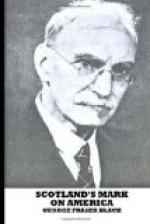Will C. Macfarlane (b. 1870), organist and composer, was born in England of Scottish origin. His compositions include songs, anthems, organ music, a Lenten Cantata, “The Message from the Cross.” His setting of Katherine Lee Bates’s patriotic hymn, “America, the Beautiful,” has had nation-wide usage. William Wallace Gilchrist (b. 1846), composer, was of Scottish descent; and Edward Alexander MacDowell (1861-1908), composer and Professor of Music in Columbia University, was of Ulster Scot origin.
Robert Campbell Maywood (1784-1856), actor and theatrical manager in Philadelphia, was born in Greenock, Scotland. Edwin Forrest (1806-1872), the celebrated American actor, was the son of a native of Dumfriesshire; and Robert Bruce Mantell, who made his debut in Rochdale, England, was born in Irvine, Ayrshire, in 1854. James Edward Murdoch (1811-93), grandson of a Scottish immigrant, was Professor of Elocution at Cincinnati College of Music, and later a leading actor on the American stage. During the Civil War he devoted his energies to support of the Union and gave readings for the benefit of the United States Sanitary Commission. Benjamin Franklin Keith (1846-1914), theater proprietor, was of Scottish descent. Mary Garden, Singer and Director of Grand Opera, was born in Aberdeen in 1877. James H. Stoddart, the veteran actor, was also of Scottish origin.
SCOTS AS INVENTORS
As Scotland gave to the world the knowledge of the art of logarithms, the steam engine, the electric telegraph, the wireless telegraph, illuminating gas, the knowledge of chloroform, and many other important inventions, it was to be expected that the inventive faculty of her sons would not fail when transplanted to this country.
Hugh Orr (1717-98), born in Lochwinnoch, inventor of a machine for dressing flax, took a patriotic part in the war of the Revolution by casting guns and shot for the Continental Army, besides doing much to encourage rope-making and spinning. His son, Robert, invented an improved method of making scythes and was the first manufacturer of iron shovels in New England. William Longstreet (1759-1814), a New Jersey Scot,




